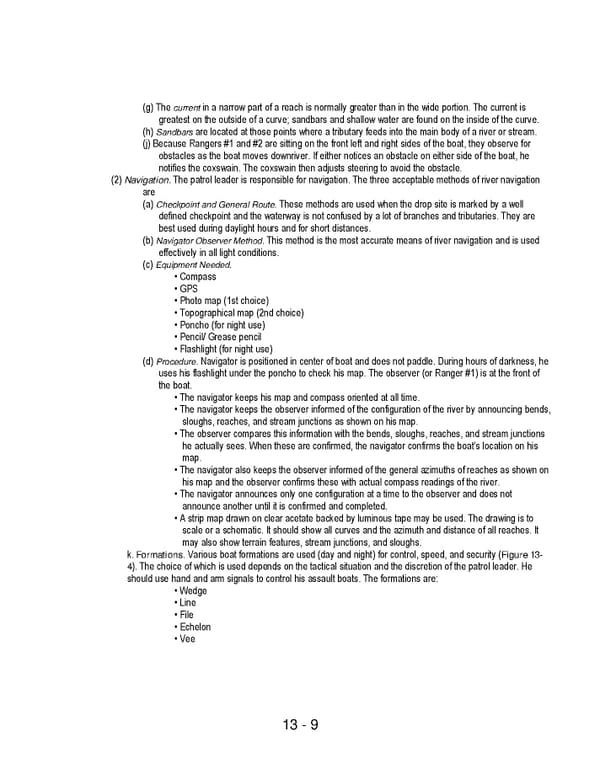13 - 9 (g) The current in a narrow part of a reach is normally greater than in the wide portion. The current is greatest on the outside of a curve; sandbars and shallow water are found on the inside of the curve. (h) Sandbars are located at those points where a tributary feeds into the main body of a river or stream. (j) Because Rangers #1 and #2 are sitting on the front left and right sides of the boat, they observe for obstacles as the boat moves downriver. If either notices an obstacle on either side of the boat, he notifies the coxswain. The coxswain then adjusts steering to avoid the obstacle. (2) Navigation. The patrol leader is responsible for navigation. The three acceptable methods of river navigation are (a) Checkpoint and General Route. These methods are used when the drop site is marked by a well defined checkpoint and the waterway is not confused by a lot of branches and tributaries. They are best used during daylight hours and for short distances. (b) Navigator Observer Method. This method is the most accurate means of river navigation and is used effectively in all light conditions. (c) Equipment Needed. • Compass • GPS • Photo map (1st choice) • Topographical map (2nd choice) • Poncho (for night use) • Pencil/ Grease pencil • Flashlight (for night use) (d) Procedure. Navigator is positioned in center of boat and does not paddle. During hours of darkness, he uses his flashlight under the poncho to check his map. The observer (or Ranger #1) is at the front of the boat. • The navigator keeps his map and compass oriented at all time. • The navigator keeps the observer informed of the configuration of the river by announcing bends, sloughs, reaches, and stream junctions as shown on his map. • The observer compares this information with the bends, sloughs, reaches, and stream junctions he actually sees. When these are confirmed, the navigator confirms the boat’s location on his map. • The navigator also keeps the observer informed of the general azimuths of reaches as shown on his map and the observer confirms these with actual compass readings of the river. • The navigator announces only one configuration at a time to the observer and does not announce another until it is confirmed and completed. • A strip map drawn on clear acetate backed by luminous tape may be used. The drawing is to scale or a schematic. It should show all curves and the azimuth and distance of all reaches. It may also show terrain features, stream junctions, and sloughs. k. Formations. Various boat formations are used (day and night) for control, speed, and security (Figure 13- 4). The choice of which is used depends on the tactical situation and the discretion of the patrol leader. He should use hand and arm signals to control his assault boats. The formations are: • Wedge • Line • File • Echelon • Vee
 Ranger Handbook Page 244 Page 246
Ranger Handbook Page 244 Page 246